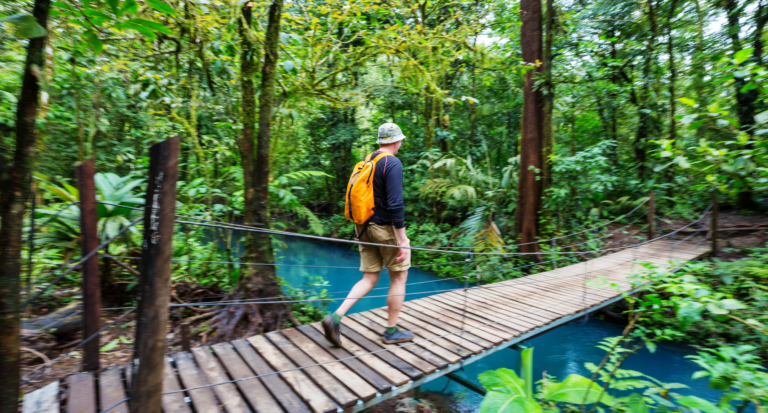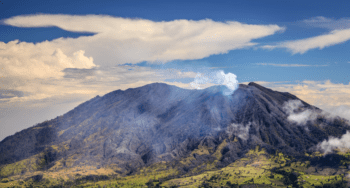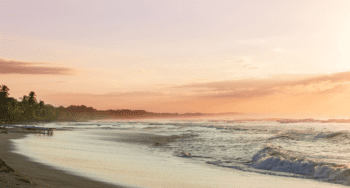Two-Week Costa Rica Itinerary: What's Covered
This 14-day clockwise route hits cloud forests, volcanoes, beaches, and wildlife without backtracking. Fly into SJO and follow: Monteverde Cloud Forest (3 days), Arenal and La Fortuna (3 days), Tamarindo beaches (4 days), then Manuel Antonio (2 days) before returning to SJO. A 4×4 is essential for Monteverde’s rough roads. Mountain roads and single-lane bridges make drives longer than expected.
Quick Facts:
- Monteverde sits 3.5 hours from SJO on unpaved roads requiring a 4×4
- Dry season (Dec-Apr) offers best conditions; green season brings lower prices
- Budget for mandatory local insurance despite credit card coverage
- Book Monteverde lodges 2-3 months ahead during high season
- Start drives at 7-8 AM for daylight arrival and wildlife viewing
Route Highlights:
- Days 1-2 – Central Valley adjustment, Poás Volcano
- Days 3-5 – Monteverde quetzal spotting, zip-lining
- Days 6-8 – Arenal hot springs, waterfall swimming
- Days 9-12 – Tamarindo surf lessons, beach hopping
- Days 13-14 – Manuel Antonio wildlife, return to SJO
Fill tanks in larger towns—remote areas have limited gas stations. Allow buffer time for Costa Rica’s relaxed pace.
If you need any help with a Costa Rica car rental, contact us now!
Planning two weeks in Costa Rica feels overwhelming at first. You’ve got volcanoes, cloud forests, Caribbean beaches, Pacific coasts, and rainforests all calling your name. Most travelers make the mistake of trying to see everything, then spend half their vacation staring at mountain roads instead of sloths.
After years of helping visitors navigate Costa Rica’s diverse regions, I’ve cracked the code on the perfect two-week route. This itinerary hits all the major highlights while giving you actual time to enjoy each destination instead of just checking boxes.
The secret? Strategic planning that follows Costa Rica’s geography rather than fighting it. You’ll start in the cloud forests, work your way to the active volcano region, hit the Pacific beaches, then finish with some wildlife time before heading home. No backtracking, minimal driving stress, and maximum “pura vida” moments.

Why Does Route Planning Matter So Much in Costa Rica?
Costa Rica’s mountainous terrain makes travel times deceiving. That 150-kilometer drive to Monteverde? Plan on 3.5 hours, not the 2 hours which would be a conservative estimate elsewhere. The winding mountain roads, single-lane bridges, and occasional construction zones add up quickly.
The weather adds another layer of complexity. Green season rains can turn dirt roads into muddy challenges, while dry season dust makes some routes less pleasant. Your timing and route order can make or break your experience.
That’s where this itinerary shines. It follows the natural flow of Costa Rica’s regions, minimizing difficult drives while maximizing your time in each destination.
Which Airport Should You Choose for This Route?
For this specific two-week route, fly into Juan Santamaría International Airport (SJO) near San José. Here’s why this makes sense:
SJO sits in the center of the country, making it the perfect starting point for a comprehensive tour. You’ll begin your journey in the Central Valley, then work your way clockwise through the country’s highlights.
Flying into Liberia (LIR) would force you to backtrack or take longer routes between destinations. Since this itinerary covers multiple regions, the central location of SJO provides the most logical access point.
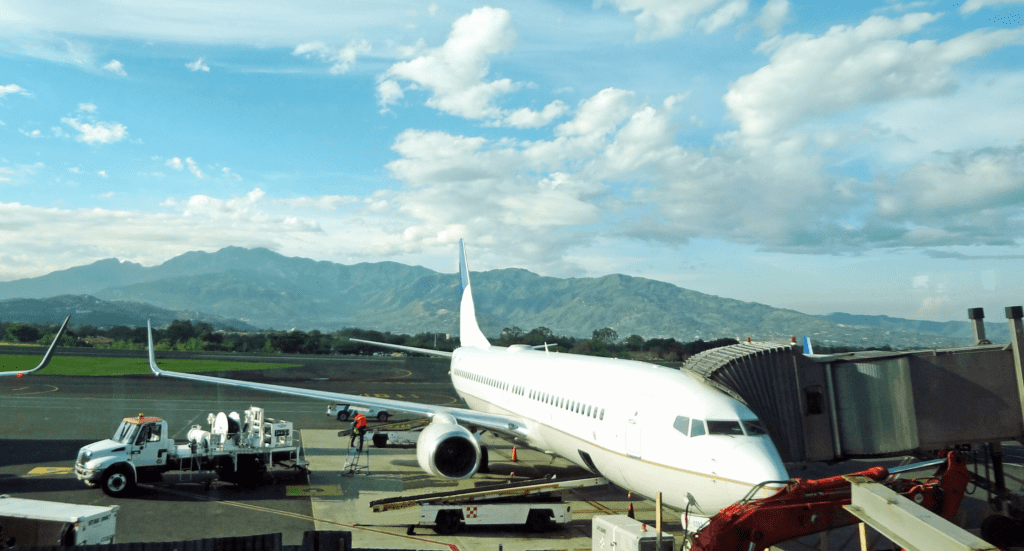
What’s the Perfect Two-Week Route Through Costa Rica?
Here’s the day-by-day breakdown that balances travel time with experience time:
Days 1-2: Arrival and Central Valley Adjustment
Day 1: Land at SJO, pick up your rental car, and drive to accommodation near the airport or in nearby Alajuela (20-minute drive). Use this first day to adjust to the time zone, grab some local currency, and stock up on snacks for the road ahead.
Day 2: Explore the Central Valley with a day trip to Poás Volcano National Park (1-hour drive from the airport area). The active crater lake provides a dramatic introduction to Costa Rica’s geological wonders. Consider combining this excursion with a trip to La Paz Waterfall Gardens to enjoy the waterfalls and wildlife found on the trails. Return to your accommodation near SJO for the night.
Days 3-5: Monteverde Cloud Forest
Day 3: Drive to Monteverde (3.5-hour drive from SJO area). The route takes you through scenic coffee plantations and up into the cloud forest zone. Check into your accommodation and spend the afternoon getting oriented to this unique ecosystem.
Day 4: Full day exploring Monteverde Cloud Forest Reserve. Take a guided morning hike for the best chance to spot the resplendent quetzal. Afternoon options include the suspension bridges or a coffee plantation tour.
Day 5: Adventure day with zip-lining through the cloud forest canopy or visiting the Selvatura Adventure Park. These activities offer different perspectives on the cloud forest ecosystem.
Days 6-8: Arenal Volcano and La Fortuna
Day 6: Drive from Monteverde to La Fortuna (3-hour drive around Lake Arenal). The route offers spectacular lake views and your first glimpse of Arenal Volcano’s perfect cone shape. Check into accommodation with volcano views.
Day 7: Arenal Volcano National Park and hot springs. Hike the park’s trails in the morning when cloud cover is typically lighter. Spend the evening soaking in thermal hot springs with the volcano silhouette visible against the night sky.
Day 8: La Fortuna Waterfall and adventure activities. The 70-meter waterfall requires a steep hike down, but the swimming opportunity in the turquoise pool makes it worthwhile. Alternatively, try canyoning or white-water rafting on the Sarapiquí River.
Days 9-12: Pacific Coast Beach Time
Day 9: Drive to Tamarindo (2.5-hour drive from La Fortuna). This route takes you through Guanacaste’s dry tropical forest landscape. Settle into beach mode with sunset drinks and dinner in this surf town.
Day 10: Beach day and surf lesson in Tamarindo. Even beginners can catch waves here thanks to the gentle breaks and warm water. Explore the town’s restaurants and nightlife in the evening.
Day 11: Day trip to nearby beaches like Playa Conchal (45-minute drive) or Playa Flamingo (30-minute drive). These offer different beach experiences – Conchal features crushed shells creating white sand, while Flamingo provides a more upscale resort atmosphere.
Day 12: Relax in Tamarindo or take a catamaran sunset cruise. These boat trips often include snorkeling stops and dolphin spotting opportunities in the Gulf of Papagayo.
Days 13-14: Manuel Antonio and Departure
Day 13: Drive to Manuel Antonio (4-hour drive from Tamarindo). This longer drive is worth it for the combination of beautiful beaches and incredible wildlife viewing. Check into accommodation near Manuel Antonio National Park.
Day 14: Morning visit to Manuel Antonio National Park for beach time and wildlife spotting. Sloths, monkeys, and colorful birds are commonly seen here. Afternoon drive back to SJO area (3-hour drive) for your departure day.

What Type of Vehicle Do You Need for This Route?
A 4×4 SUV is essential for this itinerary, particularly for the Monteverde section. The road to Monteverde includes unpaved stretches that become challenging during green season, and even dry season conditions require higher clearance.
The mountain roads between destinations feature steep grades, sharp curves, and occasional rough patches. A 4×4 provides the confidence and capability to handle these conditions while keeping you comfortable during longer drives.
For the beach portions, you’ll appreciate the higher seating position for better views of the coastal scenery. Plus, the extra cargo space accommodates two weeks of luggage plus any souvenirs you pick up along the way.
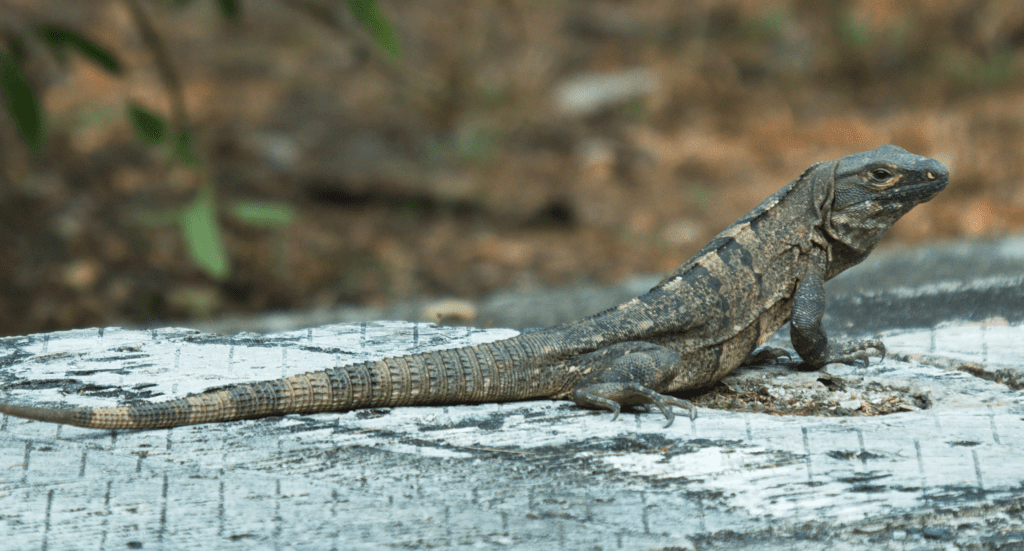
When Should You Take This Two-Week Trip?
The timing of your visit dramatically affects this itinerary’s success:
Dry Season (December-April): Perfect for this route. All roads are accessible, wildlife viewing is excellent as animals congregate around water sources, and you’ll have reliable sunshine for beach days. Book accommodations well in advance, especially for Christmas/New Year and Easter weeks.
Green Season (May-November): Still doable but requires more flexibility. Morning drives work best before afternoon rains arrive. The upside? Lush landscapes, fewer crowds, and significantly lower accommodation prices. July-August offers a “mini dry season” with less rainfall.
Avoid late September through early October if possible. This period brings the heaviest rains to the Central Pacific, potentially affecting your Manuel Antonio experience and making mountain roads more challenging.
How Should You Book Accommodations for Maximum Flexibility?
Strategic accommodation booking makes this itinerary flow smoothly:
Monteverde: Book mountain lodges 2-3 months ahead during dry season. Many properties offer package deals including meals and guided hikes.
La Fortuna: Choose accommodations with volcano views – you’ll spend evenings relaxing and watching for volcanic activity. Hot springs access is a nice bonus.
Tamarindo: Beachfront locations put you steps from surf breaks and sunset viewing. Vacation rentals work well here if you’re traveling as a family or group.
Manuel Antonio: Stay within walking distance of the national park entrance to maximize your wildlife viewing time and minimize parking hassles.

What Are the Biggest Mistakes to Avoid?
Underestimating drive times: Use Waze for accurate journey times. Mountain roads, construction, and occasional livestock on the road slow things down.
Overpacking the schedule: This itinerary includes buffer time for relaxation. Don’t try to cram additional destinations – you’ll spend more time driving than experiencing.
Ignoring seasonal road conditions: Monteverde’s access road becomes particularly challenging during heavy rains. Check current conditions before departing.
Skipping car rental insurance: Costa Rica requires local liability insurance regardless of your credit card coverage. Budget for this mandatory expense upfront.
How Do You Handle Practical Logistics on the Road?
Navigation: Download offline maps before departing each destination. Cell service can be spotty in mountainous areas between towns.
Fuel strategy: Fill up your tank in larger towns like La Fortuna and Tamarindo. Remote areas have limited gas stations.
Cash needs: Carry both colones and small-denomination US dollars. Some remote areas prefer cash, and tips for guides and restaurant staff are expected.
Emergency contacts: Keep your rental car company’s 24-hour assistance number programmed in your phone. Road conditions can change quickly during the green season.
Where Should You Splurge vs. Save on This Route?
Worth splurging on:
- Guided cloud forest hike in Monteverde (naturalist guides spot wildlife you’d miss)
- One night or at least a day pass in hot springs resort near Arenal (iconic Costa Rica experience)
- Sunset catamaran cruise in Guanacaste (dolphins and snorkeling included)
- Accommodation with volcano or ocean views (you’ll spend evenings enjoying the scenery)
Smart places to save:
- Self-guided hikes in national parks (well-marked trails don’t always need guides)
- Local sodas for meals instead of tourist restaurants (better food, authentic experience)
- Beach days without organized activities (Costa Rica’s beaches are free to enjoy)
- Grocery shopping for snacks and breakfast items (hotels often charge premium prices)

What Should You Pack for This Diverse Route?
This itinerary takes you from cool cloud forests to hot beaches, so pack strategically:
Essential layers:
- Light rain jacket (useful in cloud forests and afternoon showers)
- Fleece or light sweater for Monteverde evenings
- Quick-dry hiking clothes for multiple climate zones
- Comfortable walking shoes with good traction
Beach necessities:
- Reef-safe sunscreen (coral protection is required in marine parks)
- Water shoes for rocky beach areas
- Light, long-sleeved shirt for sun protection
- Hat and sunglasses
Technology prep:
- Portable phone charger (you’ll use GPS extensively)
- Waterproof phone case for beach and rainforest activities
- Camera with extra memory cards (you’ll take more photos than expected)

Why Does Car Rental Make This Itinerary Work?
This two-week route showcases exactly why independent transportation transforms a Costa Rica vacation. Public buses between these destinations would require multiple transfers, rigid schedules, and significantly more time in transit.
With a rental car, you control the pace. Want to stop at that roadside fruit stand between La Fortuna and Tamarindo? Done. Discover a scenic viewpoint on the drive to Manuel Antonio? Pull over and enjoy it.
The flexibility becomes especially valuable in Costa Rica, where some of the best experiences happen spontaneously. Maybe you spot a toucan in a tree beside the road, or locals invite you to a festival in a small town you’re passing through.
This itinerary works because it respects Costa Rica’s geography while giving you the freedom to experience it authentically. You’re not rushing between tour bus stops – you’re discovering the country at your own pace.
What About Weather and Seasonal Considerations?
Dry season advantages: Perfect road conditions, reliable sunshine for beach days, and peak wildlife activity. The trade-off is higher prices and more crowds at popular spots.
Green season opportunities: Dramatically lush landscapes, fewer tourists, and better accommodation deals. Afternoon rains typically clear by evening, and mornings are usually sunny for activities.
Transition periods: May and November offer the best of both seasons – green landscapes without heavy rains, moderate crowds, and reasonable prices.

How Do You Time Activities for Maximum Success?
Wildlife viewing: Early morning hikes (6-8 AM) offer the best animal spotting opportunities before temperatures rise and tourist groups arrive.
Beach activities: Late afternoon provides the most comfortable temperatures for beach exploration and the best light for photography.
Driving between destinations: Start early (7-8 AM) to arrive at your next destination with plenty of daylight for check-in and initial exploration.
Volcano viewing: Clear skies are most common in early morning and late evening. Clouds often obscure mountain peaks during midday hours.
What Makes This Route Better Than Other Options?
This itinerary follows Costa Rica’s natural flow rather than fighting it. You start in the cooler cloud forests when you’re adjusting to the new environment, then move to the adventure activities around Arenal when you’re ready for more action.
The beach portion comes during your second week when you’re ready to slow down and relax. Ending with Manuel Antonio’s combination of wildlife and beaches provides the perfect transition back to travel mode before departure.
Most importantly, the route minimizes the challenging mountain drives that exhaust many travelers. You tackle the Monteverde road early in your trip when you’re fresh, then enjoy easier coastal and valley drives for the remainder.
How Do You Make the Most of Limited Time in Each Destination?
Monteverde (3 days): Focus on guided experiences here. The cloud forest ecosystem is complex, and naturalist guides dramatically improve your wildlife spotting and understanding.
La Fortuna (3 days): Balance adventure activities with relaxation. Book one high-energy activity (canyoning, zip-lining) and balance it with peaceful hot springs time.
Tamarindo (4 days): Embrace the beach town rhythm. Mix active days (surfing, day trips) with pure relaxation. This is your longest stop for good reason – beach time shouldn’t feel rushed.
Manuel Antonio (2 days): Front-load your national park visit for the morning of your first full day. Animals are more active early, and you’ll avoid tour group crowds. The park is closed on Tuesdays so plan accordingly and buy tickets ahead of time online to avoid disappointment.
What Are Your Final Day Logistics?
Your last morning in Manuel Antonio should focus on a final national park visit if weather permits, followed by the 3-hour drive back to SJO. Plan to arrive at the airport area by mid-afternoon, giving yourself buffer time for rental car return and any last-minute souvenir shopping.
Book accommodation near SJO for your final night if you have an early morning departure. This eliminates any stress about traffic delays or navigation challenges on departure day.
Don’t pack too much into your final Manuel Antonio morning. The drive back to SJO, while scenic, requires attention on mountain curves and can be tiring after two weeks of travel.

Ready to Start Planning Your Perfect Two-Week Adventure?
This itinerary provides the framework for an incredible Costa Rica experience, but the magic happens in the details – where you stop for lunch, which viewpoints catch your eye, and how you adapt to unexpected discoveries along the way.
The key to success lies in reliable transportation that gives you the flexibility to embrace Costa Rica’s spontaneous moments while ensuring you reach each planned destination safely and comfortably.
Start by securing your accommodations for the dry season or checking availability for green season deals. Then arrange your 4×4 rental to ensure you have the vehicle capability this diverse route requires.
Most importantly, build in buffer time throughout your itinerary. Costa Rica rewards travelers who embrace its relaxed pace rather than trying to impose rigid schedules on a country that operates on “tico time.”
Your two-week Costa Rican adventure starts with smart planning and the right transportation. From there, it’s all about saying “yes” to the unexpected experiences that make this country unforgettable.
¡Pura vida, and safe travels!
